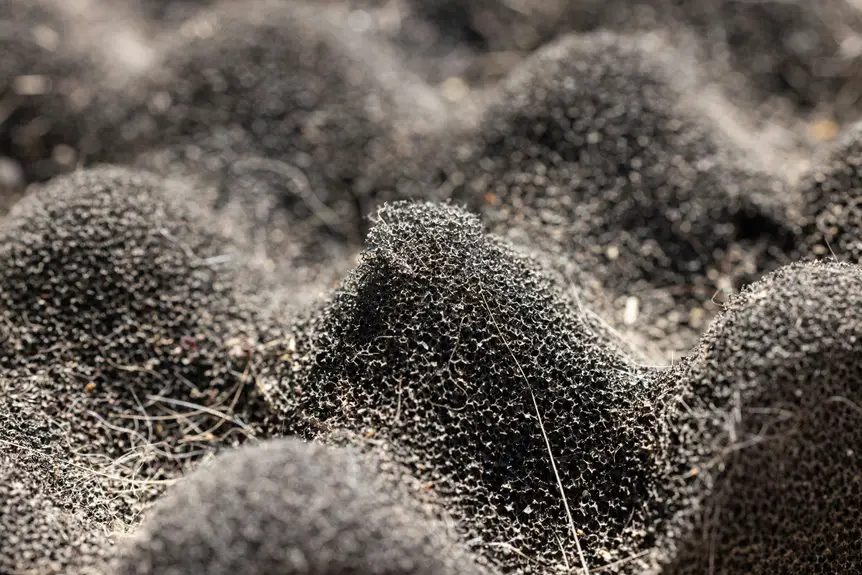Micro chamois fabric is a soft, lightweight, and highly absorbent synthetic material designed to mimic the smooth texture of traditional chamois leather. You’ll find it in sportswear because it reduces friction, wicks away sweat, and dries quickly, keeping you comfortable and chafe-free. Made from ultra-fine fibers, it’s durable and easy to care for. If you want to understand its origins, manufacturing, and how it enhances your gear, there’s more to explore ahead.
Table of Contents
Key Takeaways
- Micro chamois fabric is a synthetic microfiber designed to mimic the softness and absorbency of traditional chamois leather.
- It is highly absorbent, breathable, lightweight, wrinkle-resistant, and quick-drying, ideal for sportswear comfort.
- Manufactured from ultra-fine polyester or nylon fibers with specialized finishing techniques like brushing and heat setting.
- Commonly used in cycling shorts, athletic underwear, swimwear, and outdoor apparel to reduce friction and manage moisture.
- Proper care involves washing with mild detergent in cold water, air drying away from sunlight, and storing in breathable, dry conditions.
Origins and History of Micro Chamois Fabric
Although you might associate micro chamois fabric with modern athletic wear, its origins actually trace back to traditional chamois leather used by European artisans.
You’d find this leather prized for its softness and absorbency, crafted from the skins of chamois goats native to the Alps.
Over time, manufacturers sought a synthetic alternative that retained these qualities but offered greater durability and ease of care.
Manufacturers aimed to create a synthetic fabric combining softness with improved durability and effortless maintenance.
That’s when micro chamois fabric emerged, engineered to mimic the original material’s texture while enhancing performance.
You can appreciate how this shift from natural leather to advanced microfiber technology reflects a blend of heritage and innovation.
Key Characteristics and Properties
When you touch micro chamois fabric, you’ll notice its exceptionally soft and smooth texture that sets it apart from other materials. This fabric is highly absorbent, breathable, and lightweight, making it ideal for sportswear and cleaning cloths. It resists wrinkles and dries quickly, so you won’t have to wait long between uses. Plus, micro chamois is durable and easy to maintain, holding up well through repeated washing.
| Characteristic | Description | Benefit |
|---|---|---|
| Softness | Velvet-like feel | Comfortable against skin |
| Absorbency | Holds moisture efficiently | Great for drying or sports |
| Breathability | Allows air circulation | Keeps you cool |
| Quick-drying | Dries faster than cotton | Convenient for frequent use |
| Durability | Resists wear and tear | Long-lasting performance |
Manufacturing Process Explained
You start by choosing high-quality raw materials that guarantee durability and softness in micro chamois fabric.
Then, specific finishing techniques give the fabric its unique texture and absorbency.
Understanding these steps helps you appreciate the care behind every piece.
Raw Material Selection
Choosing the right raw materials is essential for crafting high-quality micro chamois fabric. You’ll want to start with ultra-fine synthetic fibers, typically polyester or nylon, because their fine diameter guarantees the fabric’s softness and absorbency.
These fibers mimic the texture of natural chamois leather but provide superior durability and quick-drying properties. Avoid coarse or mixed fibers, as they can compromise the fabric’s smooth feel and performance.
The fiber selection also impacts the fabric’s strength and flexibility, so you should prioritize consistency and purity in the raw materials. By carefully selecting premium synthetic fibers with uniform thickness, you assure that the micro chamois fabric will offer the signature lightweight, soft, and highly absorbent qualities that make it so versatile.
Fabric Finishing Techniques
Although selecting premium fibers sets the foundation, fabric finishing techniques bring micro chamois fabric to life by enhancing its texture, durability, and performance.
These finishing steps transform the fabric into a soft, absorbent, and long-lasting material perfect for various uses. You’ll notice the fabric’s smoothness and strength come from these careful processes.
Key finishing techniques include:
- Brushing: Raises the fabric’s surface fibers, creating a plush, suede-like feel.
- Heat Setting: Stabilizes the fabric’s dimensions, preventing shrinkage and distortion.
- Chemical Treatments: Impart water repellency or stain resistance without compromising softness.
Common Uses in Sports and Apparel
Micro chamois fabric plays an essential role in enhancing performance and comfort across various sports and apparel.
Micro chamois fabric boosts comfort and performance in sportswear and active apparel.
When you wear cycling shorts, for example, the micro chamois padding reduces friction and absorbs moisture, keeping you comfortable on long rides.
If you’re into running or hiking, apparel with micro chamois inserts helps prevent chafing and manages sweat effectively.
You’ll also find this fabric in athletic underwear and swimwear, where its lightweight, quick-drying properties matter most.
Even casual and outdoor clothing sometimes incorporates micro chamois for added softness and breathability.
Benefits Over Traditional Fabrics
When you compare micro chamois fabric to traditional materials, you’ll quickly notice its superior moisture-wicking and breathability. This fabric keeps you dry and comfortable by pulling sweat away from your skin faster than cotton or polyester.
Plus, its lightweight and soft texture feels gentle against your skin, reducing irritation during extended wear. You’ll also appreciate its quick-drying ability, which helps you stay fresh throughout the day.
Here’s what sets micro chamois apart:
- Silky smooth surface that reduces chafing
- Exceptional airflow for temperature regulation
- Durable stretch that moves with your body
Choosing micro chamois means opting for enhanced comfort and performance, especially if you lead an active lifestyle or need reliable, breathable fabric.
Care and Maintenance Tips for Longevity
To keep your micro chamois fabric in top shape, you’ll want to follow proper washing guidelines and store it correctly.
Avoid harsh detergents and high heat to maintain its softness and absorbency.
Storing it in a dry, breathable place will also help preserve its quality over time.
Washing Guidelines
Although chamois fabric is durable, you’ll want to handle washing with care to keep it soft and absorbent. Always use cold or lukewarm water to prevent damaging the fibers. Avoid harsh detergents; instead, opt for mild soap or a gentle detergent designed for delicate fabrics. Skip fabric softeners—they can clog the microfibers and reduce absorbency.
Here are some quick tips to visualize your washing routine:
- Gently hand wash or use a delicate cycle in the machine with like colors.
- Rinse thoroughly to remove all soap residue and avoid stiffness.
- Air dry flat or hang dry away from direct sunlight to maintain texture.
Storage Recommendations
Keeping your micro chamois fabric in good shape goes beyond washing—it’s equally important how you store it. You want to keep it dry, away from direct sunlight, and avoid folding it tightly to prevent creases. Instead, gently roll or lay it flat in a cool, well-ventilated space. Proper storage preserves softness and durability, making every use feel like new.
| Storage Tip | Why It Matters | How You Feel |
|---|---|---|
| Keep Dry | Prevents mildew and odors | Confident and fresh |
| Avoid Sunlight | Stops fading and weakening | Proud of lasting quality |
| Roll, Don’t Fold | Prevents creases and damage | Relaxed, no worries |
| Store Cool | Maintains fabric integrity | Comfortable and calm |
| Use Breathable Bag | Allows air circulation | Reassured and ready |
Frequently Asked Questions
Can Micro Chamois Fabric Be Recycled?
You can’t easily recycle micro chamois fabric through regular programs since it’s synthetic. However, you can repurpose it or look for specialized textile recycling options. Always check local facilities for the best eco-friendly choices.
Is Micro Chamois Fabric Hypoallergenic?
About 10% of people suffer from sensitive skin, but you’ll find micro chamois fabric’s hypoallergenic properties great. It resists bacteria and allergens, making it a comfortable choice if you’re prone to skin irritation or allergies.
How Does Micro Chamois Compare in Cost to Other Fabrics?
You’ll find micro chamois fabric generally costs a bit more than basic cotton but less than high-end synthetics. Its durability and softness make it worth the price, especially if you want long-lasting comfort.
Are There Environmental Concerns With Micro Chamois Production?
You should know micro chamois production can involve synthetic fibers, which may contribute to pollution and microplastic waste. Choosing eco-friendly brands or recycled materials helps reduce environmental impact while enjoying micro chamois benefits responsibly.
Can Micro Chamois Fabric Be Used in Upholstery?
Did you know micro chamois fabric absorbs up to 10 times its weight in water? You can use it in upholstery for moisture-prone areas, but it’s best suited for light-use spots due to durability concerns.
- Where to Buy Sherpa Suede Fabric - July 12, 2025
- How to Draw or Illustrate the Texture of Suede Fabric - July 12, 2025
- What Is Baseball Suede Leather Fabric? - July 12, 2025







